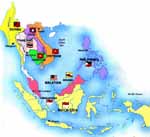-
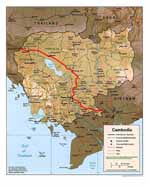 -
- Cambodia Map
-
|
-
- Map of
- Southeast Asia
|
click a picture
to see details |
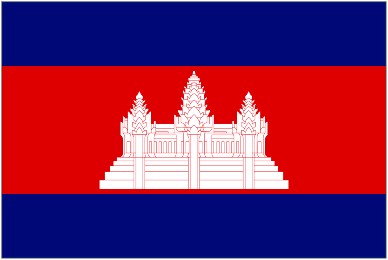
|
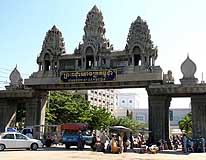
|
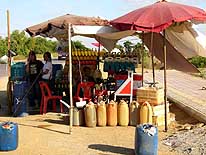
|
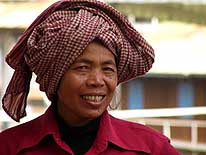
|
- With much excitement we drive through the border gate into the Kingdom of Cambodia
|
- Fuel is sold along the
- road from plastic bottles
|
- This grandmother is wearing
- the traditional head dress
|
-
- Archaic wooden hand carts packed with different goods and even people are barreled by
hand through the dusty streets. Overloaded busses and trucks push their way through the
compact crowd with all kind of merchandise. Men, women and young children carry heavy
baskets on their heads. This is the crazy and overwhelming sight at the Thailand exit
border at Aranyaprathet, as we approach it in the early morning hours of December 9, 2005.
Behind us lies Thailand, before us lures promisingly the Kingdom of Cambodia, our 151st
country. Our feelings are very mixed and every moment, we expect to be approached by an
aggressive tout – at least, this is the warning in our guide book. But everything
remains wonderfully quiet. When the golden letters „Kingdom of Cambodia“ on the
high entry gate with the Angkor Wat symbol are greeting us temptingly, a buzz of
excitement runs through us.
-
|
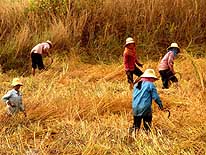
|
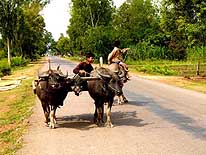
|
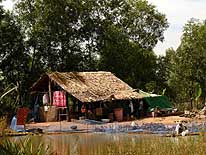
|
- Farmers are working in their rice field
|
- A water buffalo carriage
- is crossing our way
|
- Alongside the dusty road people
- live in simple dwellings
|
-
- We park in front of the visa booth and are amazed that our visas, costing US$20 per
person for a stay of one month, are ready within five minutes. This is our first surprise.
The second one follows at the immigration desk. In a third world country like Cambodia we
never expected to find its equipment as modern as in the United States. Not only our new
machine readable passports are scanned, but we even are simultaneously photographed. The
third surprise we experience at the customs. The friendly officer carefully studies our
carnet de passage and suddenly asks: “How old is your car?” We reply that it is
year 1982. “I do not think that it is allowed into Cambodia - it is too old!” We
hardly can believe his words and stare at him in disbelieve. Suddenly, he walks away and
disappears through the next door just to return shortly afterwards. With a broad smile, he
proclaims proudly: “Passed”. Later, this law does not seem so absurd to us
anymore when we see all the brand new Lexus, LandCruiser’s and Mercedes circulating
on Cambodia’s roads.
-
|
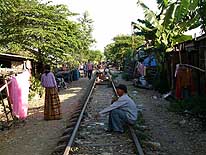
|
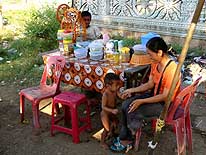
|
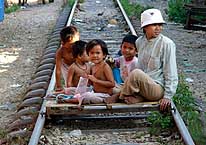
|
- The now interrupted narrow-gauge track of
- the earlier railway between Europe and Southeast Asia, leading from Russia -
- Mongolia - China – Vietnam – Cambodia to Thailand and further on to Malaysia
and Singapore, once passed between these houses
|
- A young mother is waiting for buyers
|
- A family is rolling joyfully with a
- board on the interrupted railway track
|
-
- The first overwhelming impression hits us immediately after leaving the border post of
Poipet with the many casinos attracting especially Thai people. All at once, we feel set
back for decades, as we follow the narrow gravel road full of pot holes. To our right and
to our left lush green rice fields are stretching to the horizon with farmers attending
them. Alongside, simple huts appear, built on stilts and made of any material – wood,
cardboard, tin, plastic, cloth or fiber mats. Many of them are still surrounded by small
ponds - still a result of the heavy downpours of the last rainy season. And many of them
are covered with carpets of lovely red water lilies, adding some color to the dreary
dwellings. In front of each door are huge, round clay pots where the water is stored.
There is no electricity. Rice is spread out to dry on every possible spot, even along the
road. We encounter motorcycles with live pigs, strapped to the back seat, up to three at a
time, and chickens by the dozens, dangling upside down by their feet and transported to
the market. Bullock drawn pot sellers are passing by. We definitely have plunged into a
completely different world.
-
|
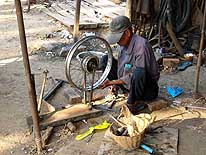
|
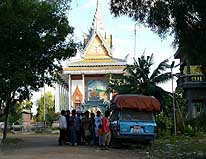
|
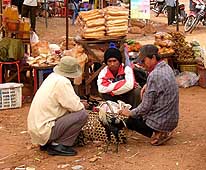
|
- A modest bicycle repair workshop
- along a road in Sisophon
|
- Our LandCruiser always attracts
- people, here at the Wat in Sisophon
|
- Men are checking their fighting cock
|
-
- Everything with two, three or four wheels is driving “slalom” on the road to
avoid all the treacherous, deep potholes. And everybody is honking strongly and
uninterruptedly when overtaking. Each time a car passes or crosses us, we are inevitably
smoke-screened by a huge cloud of red dust. We just wonder how the skinny cyclist in front
of us can cope with this situation without protecting himself with any mask. Also we ask
ourselves how people can live here at all, where everything is always covered with a film
of red dust. Or why the young boy is herding his flock of ducks exactly on the side of the
road where the dust catches him the most.
-
|
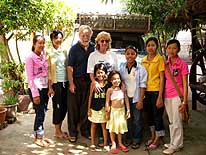
|
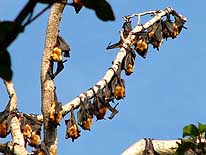
|
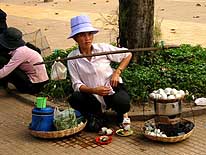
|
- The family of the Ratana Guesthouse
- in Siem Reap, posing for a picture
|
- The tree branches at the ‘Royal Independence Gardens’ in Siem Reap are crammed
with bats
|
- Making a short afternoon break
|
-
- When mid afternoon we reach Sisophon, the first small town, we definitely need a break
from all the swallowed dust and decide to spend the night here. Strolling through the
streets, we realize that people might soon suffocate from their own garbage. Even in the
richly decorated Wat – the Buddhist temple - which in Thailand always are clean and
oasis of tranquility - plastic and paper decorate the floor everywhere. Between the many
dilapidated buildings, we discover to our amazement a narrow-gauge track – part of
the earlier railway from Europe to Southeast Asia through Russia - Mongolia - China –
Vietnam – Cambodia to Thailand and further on to Malaysia and Singapore. Now it is
interrupted in Cambodia, destroyed by the Khmer Rouge in the late seventies and has become
the playing field for children, who joyfully roll on them with simple boards.
Coincidentally, we lately just heard on TV, that Vietnam has offered as a development aid
to reconstruct the missing stretch as far as Phnom Penh. For the continuation to the Thai
border, it looks that additional donors from other nations have to be found.
-
|
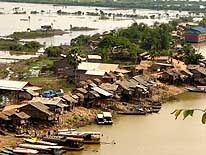
|
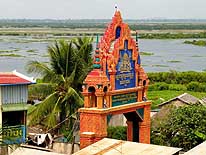
|
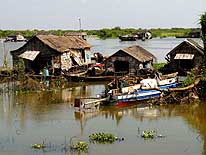
|
- View of the floating village of
- Phnom Krom at the ‘Tonle Sap’-Lake
|
- View of the wetlands
- of the ‘Tonle Sap’-Lake
|
- The floating houses at
- the ‘Tonle Sap’-Lake
|
-
- Next day, we are approaching Siem Reap with the legendary Angkor temples - a UNESCO
world heritage site. Entering the town, we are really surprised to find so many luxury
hotels lining up - what a striking difference to all the simple dwellings we just passed.
On the lookout for a cheap guesthouse, we stop at the roadside, where a couple of
motorbike drivers are resting under a shady tree. As soon as we step out of the car, one
of them points to our back left tire, which is loosing slowly but steadily air and we
discover also the thick screw, causing our 154th flat tire. How annoying, not really a
nice welcome to Siem Reap! Of course, we have to change it immediately. Luckily, it does
not take long to find nearby a clean air-conditioned room at the Ratana family guesthouse
on the airport road for relatively little money: US$10.
-
|
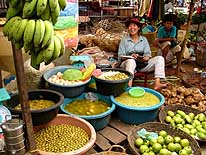
|
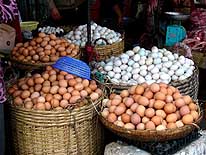
|
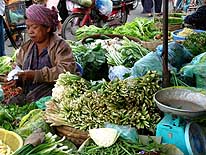
|
- A happy young vendor in the
- market of Siem Reap
|
- There is no shortage of eggs
- in the market of Siem Reap
|
- Also the choice of vegetable is plentiful
|
-
- But what we need the most now are some ice cold beers. Therefore, we head straight away
into town, just two miles away. By chance, at the ‘Royal Independence Gardens’
with their beautiful alleys of old trees, we find a perfect spot to park the car. Above
our heads, the branches are crammed with bats – hundreds of them - producing an
overwhelming noise. Amazingly, they are day active and from time to time they suddenly fly
away only to settle down a few minutes later again. In front of us, the golden ‘Preah
Ang Chorm Shrine’ is shining in the bright light of the evening sun with a freshly
married couple posing in front of it for some wedding pictures. Besides us is one of our
favorite trees - the “voyageur” - the “travelers” tree –
resembling a huge fan, and in front of us, a flower stall is selling beautiful garlands
and bouquets made from exotic blossoms for religious offerings – a sight which soon
makes up for our initial bad start!
-
|
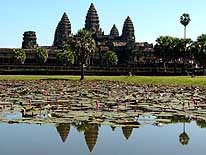
|
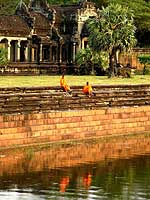
|
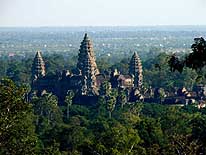
|
- Angkor Wat reflecting in
- the pond filled with lilies
|
- Two Buddhist monks in their
- shiny saffron robes sitting on
- the steps of the Angkor Wat
|
- The main temple of Angkor Wat with
- its five towers viewed from the hill
- of the ‘Phnom Bakheng’-Temple
|
-
- The next day being a Sunday is not really recommendable for exploring the overcrowded
ruins of Angkor. Therefore, we decide to visit the floating village at Phnom Krom on the
nearby Tonle Sap Lake with its simple huts made of bamboo and palm tree leafs instead.
Also here, life seems to be still the same as it has been half a century ago and probably
still will be the same for decades to come. It is an autonomous world in itself, with
children going by boat to their floating school and with groceries paddled by boat from
door to door. But we find also many fishermen huts along a narrow, dusty, potholed earth
dam. Through their thin walls made of palm leafs, we see whole families sitting on straw
mats on the floor. Most of their belongings are stapled outside, beside the street –
from cooking pots, water containers, wood, fish on racks to dry and bicycles. And amidst
of all the stuff, children are playing joyfully with a ball, a women is frying something
indefinable, a boy is sucking tiny raw ousters, men are playing cards – and
astonishingly, nobody minds at all that we are taking discretely pictures. It really is
surprising that people have not attracted the “tourist fatigue” yet, as day by
day rickshaws with tourists are passing by on their way to board one of the many boats
lining up, heading for Phnom Penh or other destinations.
-
|
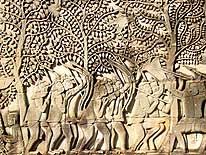
|
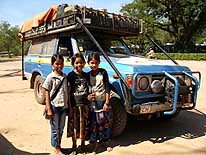
|
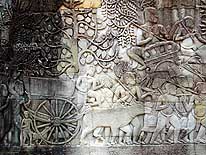
|
- One of the many magnificent
- bas reliefs of Angkor Wat
|
- Three sweet girls try to sell postcards and Lonely Planet guide books at the ruins
|
- Many of the relief’s of Angkor depict
- episodes from the war and daily life
|
-
- “Do you have a drivers license?” asks us the young man at the toll station to
the Angkor ruins the next day, as we give him US$40 per person together with a photo to
get a three days personal entry pass in return – unfortunately valid only on three
subsequent days (one day alone costs 20, 6 subsequent days US$60). He really is serious
about his question and adds: “Otherwise you will get into real trouble if somebody
checks you”. His childish naivety makes us smile! We are so happy that we are allowed
to explore these unique, widely spread temples with our own car. Already on our way to the
first one, we enjoy the ride along the peaceful lake with some patches of red water lilies
floating, the green canopy of the still mostly untouched forest and the encounter with a
curious family of monkeys hanging around at the roadside on the lookout for some food from
the many visitors driving past. But at the parking lot of Angkor Wat, it is a different
story: It is packed with tour busses, food stalls, souvenir shops and children who, among
other things, sell postcards and inexpensive pirated Lonely Planet guide books for other
countries (we find out though, that mostly only the cover is new, and the content is a
photocopy of an older edition). Very cute is a small girl who follows us all the way to
the entrance of the temple and asks us where we come from. When we say Switzerland she
adds: “Berne is the capital”. Not all of the children have learnt their lesson
so well, but for the time being, it seems to be their nice way to make contact with
potential customers.
-
|
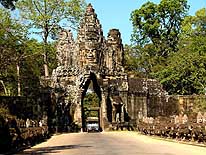
|
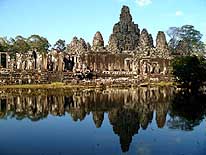
|
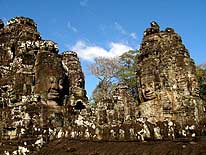
|
- Our LandCruiser is driving through the gate to the Bayon temple with its gigantic stone
faces
|
- The Bayon temple is
- reflecting in the calm pond
|
- Gigantic stone faces stare at us from
- each angle of the Bayon temple
|
-
- Standing in front of the ruins of ‘Angkor Wat’, we feel the same sensation of
greatness and uniqueness we experienced elsewhere at other extraordinary places in the
world: It was at the Maya ruins in Tikal/Guatemala, at Peru’s Inca town of Machu
Picchu or at the Taj Mahal in Agra/India. Amongst its splendid ruins, this ancient
civilization seems to come to life again. Angkor was built in the 12th century and has
been greatly influenced by Indian architecture. What most impresses us is the wealth of
the intricately carved bas reliefs, ornamenting entire walls and pillars, mostly telling
episodes of the life of the Khmer Empire. The center is the 175ft high main tower, flanked
by four smaller ones. Climbing up the steep, often crumbling steps brings back memories of
Tikal again, where the steepness, height and the collapse was much more dramatic and where
the purely thought to have to descend again, made our blood freeze. Here it is rather the
never ending stream of visitors, which is dramatic. When one of the many tour groups
arrives, a one way system applies! Nevertheless, we still are able to find some peaceful
moments: At noon, when most of the tour groups return to their hotels for lunch, or in the
evening, when the majority is climbing to the hill of the ‘Phnom Bakheng’ Temple
for sunset. Then we return to the silence of the water lily pond in front of this great
temple waiting anxiously for the “picture book” sunset to appear. But we wait in
vain - the first day, the second day and also the third day.
-
|
-
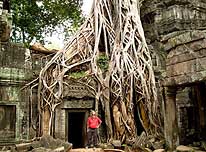
|
-
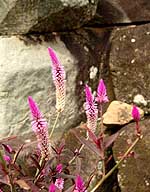
|
-
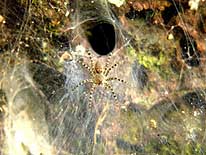
|
- The temple of ‘Ta Phrom’,
- engulfed by the roots of a fig tree
|
- Flowers are blooming through
- the cracks of the ruins
|
- The ruins are the home of dozens
- of spiders, which retreat in their
- holes at the slightest movement
|
-
- Our second favorite temple is the Bayon with its 216 giant stone faces watching over us
from every angle of its 54 towers. It is a magic place, which we enjoy for hours as we are
able to picnic in our car right in front of it. Our third preference is ‘Ta
Phrom’, left mostly as it was a 100 years ago. The stone structures are entangled by
impressive roots of the fig trees, which now support most of the structures keeping them
in place. It is an extraordinary sight to watch the jungle swallowing step by step parts
of this great ancient civilization. Very impressive are also the elephants and
leper’s terraces with their outstanding reliefs, which we admire for hours and where
we are able to park for lunch under a shady tree just opposite to them.
-
|
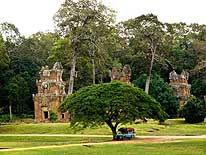
|
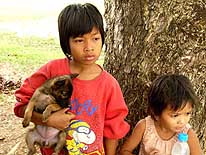
|
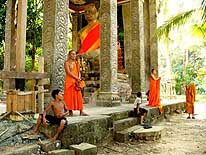
|
- Our shady picnic spot opposite
- the Elephant and Leper’s terraces
|
- Two sisters and their dog visit us
|
- Monks and children in front of
- a Buddha image at the ruins
|
-
- It is a big advantage that we can park within the ruins in many places. Also within the
temples itself, there are no restrictions of movement. We are allowed to wander around
freely everywhere, unless renovation work is in progress. We wonder however, how it will
be by 2010, when they plan to receive 4 millions visitors per year instead of the nowadays
1 million. On our third and last day, we drive the big circuit and explore also the
smaller temples, which are scattered 12 miles around in the jungle. Each one is different
and special in its own way again. The most treasured moment though occurs on our last
evening in front of the main temple ‘Angkor Wat’. The crowd has left already,
complete silence has returned and the moon is rising slowly behind the ruins, adding even
more mystery to this most beautiful temple of the great Angkor Empire.
-
|
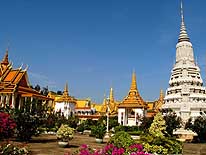
|
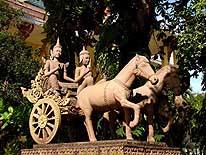
|
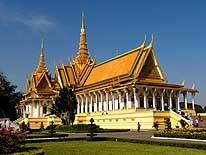
|
- The splendid Royal Palace of King
- Norodom Sihanouk in Phnom Penh ..…
|
- ..... the Royal carriage .....
|
- ..... and the throne hall
|
-
- Hence rural life is catching up again, as we drive 200 miles on the good and new tarmac
road to Phnom Penh. The capital of Cambodia is not love at first sight. On our first day,
we feel quite distressed at the big number of begging children, who follow us persistently
with open hands and imploring eyes. But soon we realize that they belong to the image of
Phnom Penh as do the luxury cars of the privileged. Later we learn that they are not
opportunists, but a well organized “mafia” of beggars, making up to US$400 a
month from Western tourists. But after some days, we get accustomed to them and they do
likewise the same. We are becoming a kind of attraction with our special car too. Whenever
and wherever we park the vehicle, we become surrounded by a crowd of curious people who
admire and study the list of visited countries listed on both sides of the car, trying to
count them and start to talk to us in Cambodian despite that we do not understand one
word. Sometimes somebody speaks a little bit English, usually then translating loudly
everything, what attracts more and more people. And after some days, we even start to like
Phnom Penh – its provincial character, broad avenues and slow, rather relaxed
traffic; but also the range of cheese and ham in the two major supermarkets, the exotic
street markets, the many internet cafes and the numerous choices of restaurants are nice
to explore. Our favorite spot remains the Mekong river front, which gets very lively with
families in the evening when the heat cools down and where always at the same time
“Rambo”, the old elephant, is passing by with its mahout on its way home.
“Rambo” loves our bananas, which disappear always very fast in its throat.
-
|
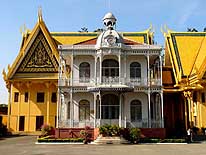
|
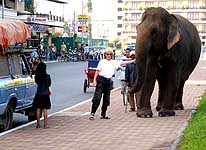
|
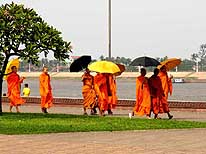
|
- The ‘Iron House’ in the
- Royal Palace in Phnom Penh
|
- „Rambo“, the Elephant, trotting
- with its mahout through Phnom Penh
|
- Monks wandering around the city
|
-
- At noon, when the scorching sun is burning from the sky, we park under a shady tree on a
quiet area along the Mekong River and eat mostly out of our board kitchen. Our neighbors
are a couple, living in a dilapidated wooden hand cart with their few belongings. Like
many others too, they are collecting plastic bottles, beer cans and cardboard to make some
money. If it starts to rain, they just cover their “home” with a plastic tarp.
For their daily shower, they use a coincidentally available water hose which seems never
to be turned off. Many times, both of them just doze. We see them every day, and they are
always in good mood and never become “sticky”. What could we spare from our
“household?”. I am searching in our LandCruiser and find some clothes, shampoo,
soap, tooth brushes, toothpaste and a comb with a mirror. The next day, the slim woman
wears my blue blouse and is washing her hair with the given shampoo.
-
|

|
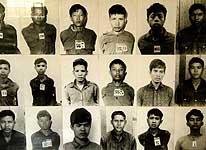
|
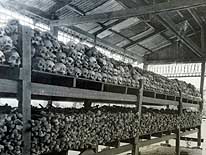
|
- A Chinese tomb on a hill
|
- The ‘Tuol Sleng’-Museum in Phnom Penh
- with its moving photos of prisoners ..…
|
- ..... and the mountains of skulls and bones
|
-
- Unfortunately, they are not the only homeless people. Whole families live in similar
dreadful conditions with their children, often just under a tarp along the river shore.
And in sharp contrast, unscrupulous government officials and NGO’s are cruising with
their luxury Lexus’ and expensive LandCruiser’s through Phnom Penh’s street
– and not only a handful! It is the biggest gap of rich and poor we have ever seen in
a country before. When darkness is falling, we drive over the bridge out of town five
miles back in direction Siem Reap to our ‘Chai Hong’ Hotel. Very soon we realize
that it is a “out of the ordinary” hotel. Every evening, dozens of very young
girls, beautifully dressed in evening robes, wait for customers. But we do not care: The
room is clean and air-conditioned, has hot water, a fridge and TV, the linen is changed
daily including mineral water, soap, tooth brush and toothpaste - and our car has a safe
parking lot. For only US$6 a night, we do not mind to vacate it every morning for the use
of the ‘hourly guests’.
-
|
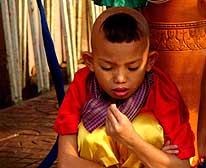
|
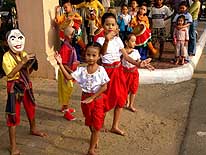
|
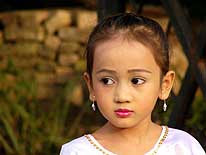
|
| Children in Phnom Penh
practicing a dance |
-
- Again and again we wonder how this people were able to keep and regain their admiringly
lovely nature, their broad smiles and their cheerfulness despite the overwhelming poverty
and the incredible atrocities they had to endure firstly under the terror regime of the
Khmer Rouge and then during the Vietnam war. Their terrible past is still weighing heavily
on the country. Alone the sight of the many people with amputated or deformed limbs is
testimony of this cruel past. One day, we decide to visit the ‘Tuol Sleng’
Genocide Museum, which in earlier time acted as a high school, but was transformed by the
Khmer Rouge into the main house of torture. Its victims were especially the wealthy
intellectuals (wearing glasses or just knowing a foreign language meant automatically
belonging to this class) collected from all over the country - regardless of their
nationality, but also every man, woman or child suspected of opposing Pol Pot’s
vision for a peasant-dominated agrarian society.
-
|
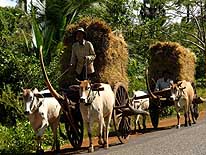
|
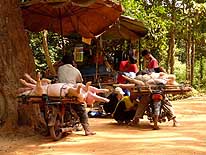
|
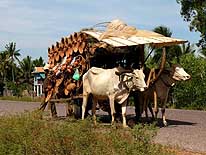
|
- Rural Cambodia
|
- Everything is transported on
- motorbikes, even living pigs
|
- A clay pot seller on the tramp
|
-
- They were kept in small cells and shackled with chains fixed to the walls or the
concrete floor. In each cell, the regulations were posted on small pieces of black board,
one of them reading: “While getting lashes or electrification, you must not cry at
all”. One room is filled with wrenching photos of victims awaiting their fate, and
shocking pictures of mountains of skulls and bones. Another room depicts many moving
family dramas. They tell from loved ones who one day were fetched by solders and have
never returned, their fate still being unknown. Inevitably, memories of the horrendous
atrocities of the Nazi regime come back as well as certain similarities from our visit to
the Auschwitz concentration camp in Poland, only that Cambodia’s genocide has largely
remained unnoticed by the world community. We read some overwhelming figures: Killed or
disappeared: 3.3 millions people; destroyed: 635’000 homes, 5’857 schools, 796
hospitals, 2’100 houses of worship; missed: 1½ million cattle.
-
|
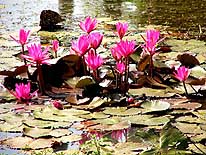
|
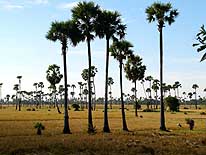
|
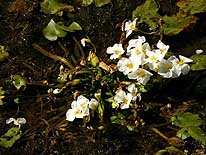
|
- Ponds with red water lilies are a common sight
|
- Majestic palm trees dot the plain
|
- White flowers in a pond along the road
|
-
- All what we have just seen and read is so disturbing, that we do not want to make our
hearts heavier by visiting also the “Killing Fields”. Therefore, we give them a
miss – may be for wrong. Instead we head to the splendid Palace of King Norodom
Sihanouk and admire the Throne Hall with the golden throne and the beautifully painted
ceiling; the Silver Pagoda which is named in honor of the 5’000 silver tiles that
carpet the floor, weighing 2 pounds each; a Buddha made of solid gold, covered with
hundreds of precious diamonds and a wealth of other valuable objects of the Khmer
civilization. In its lush gardens, the pyramid shaped shrines of Kings offer another
striking sight. The entire splendor immediately transfers us into a completely opposite
world, into a dreamy world.
-
|
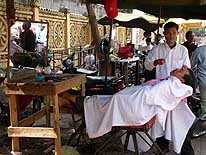
|
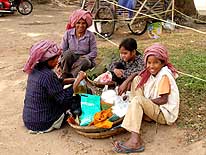
|
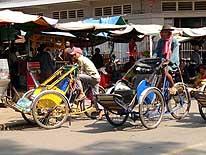
|
- Barber working under an umbrella
- in a street in Phnom Penh
|
- Sitting and chatting
|
- Bicycles in the market street of Phnom Penh
|
-
- Christmas is on the door steps – without any nostalgic Christmas music and without
any sign of festive lights illuminating the city of Phnom Penh. It is exactly on December
25th, when we finally decide to move on towards the Vietnam border. Everything is going
along just nicely, until we reach the mighty Mekong River skirted by simple dwellings,
where a car ferry is crossing to the other side. Immediately, I am captivated by the
lively scene around us: The waiting busses, where whole families, even with small children
sit on the roof on top of all kind of goods and where young girls gather in groups on the
pavement, selling fruits and all kind of exotic food. I leave our car to make some
pictures while Emil prefers to remain inside, surrounded by all the persistent vendors.
-
|
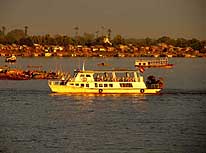
|
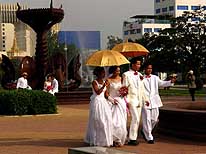
|
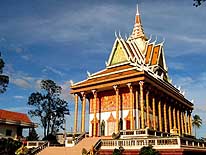
|
- Rays of the setting sun across
- the river in Phnom Penh
|
- A wedding in the city park
|
- One of the many lovely temples,
- looking like a castle
|
-
- Suddenly, I am pushed and smashed strongly to the floor and I feel a terrible pain. Only
now I begin to realize that a Cambodian hit me from behind with his car and has rolled
with the front wheel over my left leg. I am panicking and screaming and at the same time
the crowd around me starts to shout as well. Until Emil - who is still sitting in the car
- understands what happened, I am already surrounded by dozens of curious people.
Immediately, he pushes his way free and drags me carefully back to the car. Not hesitating
one moment, he turns around immediately and speeds the 40 bumpy miles back to Phnom Penh.
In between, he puts two pills of 500mg Aspirin into my mouth – firstly against the
increasing pain and secondly for thinning my blood. It would not have made any sense at
all to argue with the responsible, probably drunken driver as mostly they are not insured
anyway and the culpable is always the foreigner for the mere reason of being present: If
he wouldn’t have been here, it wouldn’t have happened! Much more important was
that I get the right medical treatment as quickly as possible.
-
|
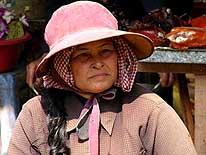
|
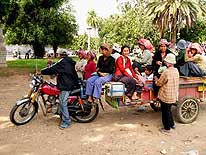
|

|
- This woman’s head protection
- is typical for Cambodia
|
- A common sight: trailer packed
- with people, drawn by a motorbike
|
- Happy face in Phnom Penh
|
-
- In the capital of Cambodia, we head straight for the first hospital described as
reliable in the Lonely Planet Guide. It is the Naga Clinic under French Management, where
we can communicate with the doctors at least in French. At that time, my leg has reached
already the double of its normal size. I am rushed to make an x-ray which shows that it is
luckily “only” a straight bone fracture and that the broken part is not
displaced. It could have been much worse if this idiot had hit my ankle-joint. Then, I
would have had to be flown out to Bangkok for surgery, as Cambodia is not necessarily the
best place to have done a complicated operation. Being Christmas day, the doctor for
splinting my leg is at home, celebrating with his family. He has to be called by phone.
Soon afterwards, he arrives with his little son and with the help of a nurse; he plasters
my leg up to the knee.
-
|
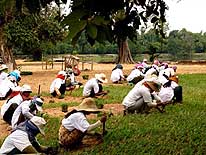
|
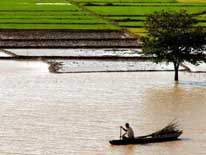
|
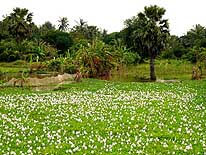
|
- Grass is still planted by hand
|
- Where rice fields meet
- the Mekong River
|
- A meadow with blooming hyacinths
- on our way to the Vietnam border
|
-
- When I ask him, whether I am allowed to continue the next day to Vietnam, he probably
thinks that I am completely crazy. He repeats not only once but several times that we have
to watch my leg very carefully because the risk of a thrombosis is not to be
underestimated and cannot be excluded. Then he gives me some pills to dilute the blood,
antibiotics, aspirin and a strong pain killer and shows us on the city map where we are
able to buy a crutch on Christmas evening. As we wave good-bye to the friendly doctors, we
once more realize that in third world countries, the well-being of the patient comes
always first and only secondly the payment (we made the same experience 1993 in Bangkok,
when Emil had to be hospitalized for food poisoning). Exactly the opposite we remember
from Las Vegas, when both of us caught the really bad millennium flue at the same time and
had to wait with high fever in a cold hospital lobby for at least half an hour, until our
admission papers and credit card payment were settled! Being really worried about the
danger of a clot of blood, we decided to postpone our departure to Vietnam one more day.
-
|
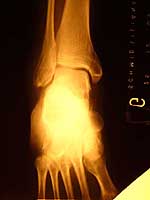
|
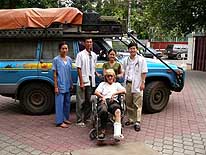
|

|
- The x-ray shows Liliana’s fractured leg –
- on the right in the upper third part
|
- The friendly doctor’s team at the
- Naga Clinic in Phnom Pen
|
- Liliana with her cast in front
- of a Durian fruit tree
|
-
- On December 27, 2005, we finally make our second and final attempt to reach the Vietnam
border. At the Mekong ferry, the same young vending ladies rush immediately again to our
LandCruiser and push their heads through the window. This time though, they do not want to
sell us something; they just want to check how I am doing. When they see my thick cast and
my swollen leg - which started in the meantime to change its color into black - they look
very concerned. I am moved when one of them insists that I accept her huge pealed
grapefruit as a farewell gift. This lovely gesture belongs to our last beautiful memories
of Cambodia - a country, whose people have captivated us from the very beginning with
their broad smiles. A different story is that I am leaving Cambodia with an extraordinary
“Christmas present”, a plastered leg, just because two days ago I was standing
at the wrong time on the wrong place. Luckily, at that moment, we did not know yet all the
consequences of this Christmas day. When we board the ferry towards a new country –
Vietnam - , people are waving at us and we are waving back at them.
-
|
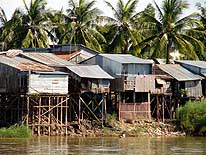
|
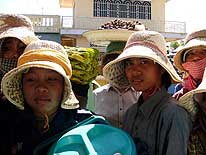
|
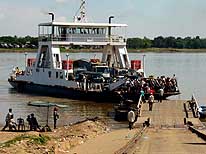
|
- Dwellings on stilts skirting
- the Mekong River
|
- Young women sellers at the Mekong
- ferry looking curiously for the broken leg
|
- The Mekong ferry brings us
- to the other side of the river
|
-
|
![]()

